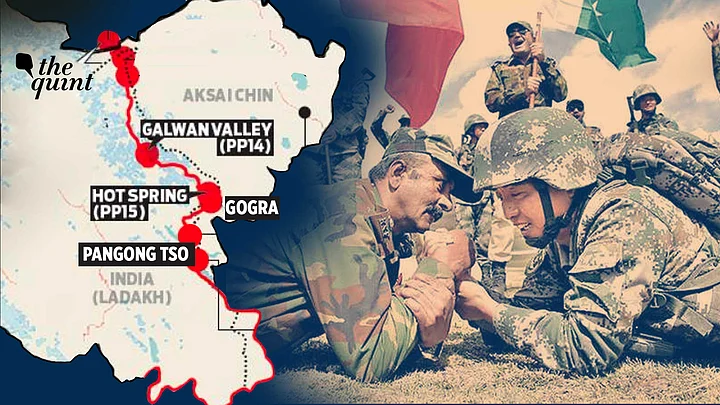India and China have announced a disengagement of their forces from Patrolling Point-15(PP) in the Gogra-Hotsprings of East Ladakh on 8 September. Following disengagements in the Galwan Valley in 2020 and Pangong Tso in 2021, this is another step towards restoring the status quo as of April-May 2020.
Beginning May that year, the People’s Liberation Army (PLA) had occupied positions in five areas, blocking Indian troops from patrolling up to their claim line. In one majorly violent incident arising from this conflict, the Chinese and Indian troops clashed in Galwan resulting in the loss of 20 Indian and four Chinese lives. This has had a profoundly negative effect on Sino-Indian relations ever since.
Rampant Military Violations by China in the Past
Besides this, the Chinese massed 50,000 troops close to the Line Of Actusl Control(LAC). This violated Article IV of the 1996 treaty on military Confidence-Building Measures (CBMs) which restricts the use of firearms during faceoffs. This also states that both sides should avoid holding large-scale military exercises involving more than one Division, (roughly 15,000 troops) near the LAC.
Secondly, it mentions that if there was an exercise of more than a Brigade of 5000 troops on either side, there should be a prior notification of the type and duration of the exercise.
However, the Chinese troop deployment remains unchanged as of now, as well as a comparable Indian counter-deployment.
In the real world, there is no turning the clock back. Even if India can now persuade the Chinese to back off in the two remaining areas in Depsang and Charging Nala area, things will not change.
All the other so-called friction points involved tiny bits of territory, Depsang is the big one. This has led to Indian forces being blocked from patrolling 1,000 sq kms. Till recently the government did not even acknowledge this, terming Depsang a “legacy issue”.
India's Lessons from the Galwan Violence
Given that the entire LAC is disputed, trust was a key component in maintaining peace there along with a slew of CBMs. Both have gone for a toss following the Chinese action and restoring normalcy therefore, will not be easy.
As it is, even the process begun in separating forces in Galwan, Pangong Tso, the Kailash Range and PP15 are not really a restoration of status quo. The forces have disengaged and a No-patrol zone has been created in each location.
There is some confusion over just where PP15 lies. It is near Jianan Pass (34°32'24.7"N 78°38'10.7"E) along the LAC, lying on the watershed between the Kugrang and Galwan river basins. Gogra and Hot Springs lie anywhere 40 kms to the south-east.
There should be no doubts where the LAC lies here since the Chinese provided us a detailed description of this line in the talks in 1960 and said that in this area it follows the watershed between the Kugrang Tsanpo river the its tributary, the Changlung.
The Indian statement refers to the area as Gogra- Hotsprings, whereas the Chinese official statement is more accurate and says that the disengagement will take place at “Jianan Daban” region. This is an extremely remote area though going by satellite imagery there is a 20 km road that runs from the pass along a stream that eventually reaches the Kugrang. From its location it seems this is a road that has been used by Chinese vehicles in the past, too, but it is clearly through Indian territory. This is an alternate route to the Galwan river and for this reason the Chinese maintain strong defenses here.
Will This Pullback Ease Friction Between India and China?
The way the Indians see it is that following disengagement of the forces involved in the face-to-face confrontation, the two sides can then begin the process of building down their militaries which have been massed on either side of the LAC for the past 28 months. China’s approach, however, seems to be that India is needlessly hyping the situation. They feel that the two sides should separate issues relating to the border from relations in other areas. But India has been firm and EAM Jaishankar has categorically asserted that there can be no normalization, unless the 2020 clock is turned back.
But even if it does, the issues will not go away. The border will remain disputed and militarised. Trust was not something abstract but rather had been built carefully through a number of confidence-building agreements beginning with the 1993 Border Peace and Tranquility Agreement and endured till the 2020 events. Restoring this will not be easy.
And then, we can’t talk of new CBMs, before we are willing to confront the circumstances in which the old ones were destroyed. The ongoing negotiations seem to shaping a new concept—that of establishing no-patrol zones in the contested parts of the LAC. This is not a bad idea, except that in eastern Ladakh, in Pangong Tso, Galwan and Gogra-Hotsprings, the no patrolling zones are often at the cost of India. You can be sure that the disengagement at PP15 will also be at India’s cost
Is the worst over in the LAC ? Unlikely. The entire border is disputed. Many in India think that it has been largely stable and will remain that way, but the Chinese have a nasty habit of shifting goalposts. Remember, the Chinese now call Arunachal Pradesh, South Tibet. Since 2017 they have begun a massive buildup in Tibet, creating billets for troops, new heliports, hardened facilities in air bases and so on.
India, too, has oriented its army northwards and is also building up its facilities. So the danger of war is there and will remain till the border dispute is resolved.
(The writer is a Distinguished Fellow, Observer Research Foundation, New Delhi. This is an opinion article and the views expressed are the author's own. The Quint neither endorses nor is responsible for them.)
